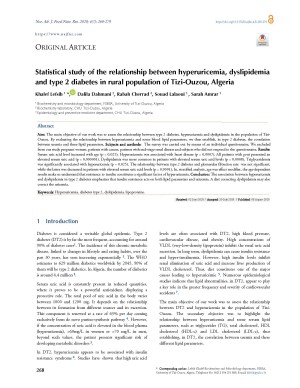Statistical study of the relationship between hyperuricemia, dyslipidemia and type 2 diabetes in rural population of Tizi-Ouzou, Algeria
Abstract
Aim : The main objective of our work was to assess the relationship between type 2 diabetes, hyperuricemia and dyslipidemia in the population of Tizi-Ouzou. By evaluating the relationship between hyperuricemia and some blood lipid parameters, we thus establish, in type 2 diabetes, the correlation between uremia and these lipid parameters. Subjects and methods: The survey was carried out by means of an individual questionnaire. We excluded from our study pregnant women, patients with cancer, patients with end-stage renal disease and subjects who did not respond to the questionnaire. Results: Serum uric acid level increased with age (p = 0.025). Hyperuricemia was associated with heart disease (p = 0.0007). All patients with gout presented an elevated serum uric acid (p = 0.000001). Dyslipidemia was more common in patients with elevated serum uric acid levels (p = 0.0008). Triglyceridemia was significantly associated with hyperuricemia (p = 0.025). The relationship between type 2 diabetes and glomerular filtration rate was not significant, while the latter was decreased in patients with elevated serum uric acid levels (p = 0.0001). In, stratified analysis, age was effect modifier, the age-dependent results make us understand that resistance to insulin constitutes a significant factor of hyperuricemia. Conclusion: The association between hyperuricemia and dyslipidemia in type 2 diabetes emphasizes that insulin resistance acts on both lipid parameters and uricemia. A diet correcting dyslipidemia may also correct the uricemia.
Full text article
Authors
Copyright (c) 2020 Authors

This work is licensed under a Creative Commons Attribution 4.0 International License.
-
Attribution — You must give appropriate credit, provide a link to the license, and indicate if changes were made. You may do so in any reasonable manner, but not in any way that suggests the licensor endorses you or your use.
-
No additional restrictions — You may not apply legal terms or technological measures that legally restrict others from doing anything the license permits.





